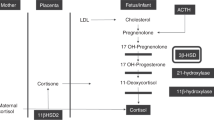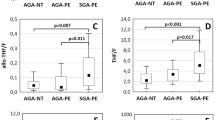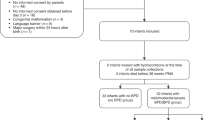Abstract
Objective
The aim of this study is to establish the serum level distribution of cortisol and ACTH in VLBW preterm newborns and determine which neonates are ideal candidates for the stimulation test for adrenal insufficiency.
Methods
Plasma cortisol and ACTH levels were evaluated in 416 VLBW newborns on days 1, 7, and 30 of life. Gender, gestational age, weight, type of delivery, RDS prophylaxis, and perinatal morbidities were considered as potential variability factors.
Results
Cortisol and ACTH levels significantly decreased between 1, 7, and 30 days. Significantly higher cortisol levels were found at lower gestational ages and in infants born by vaginal delivery, whereas lower levels were observed in those born after maternal corticosteroid treatment. The distribution of cortisol and ACTH levels in healthy infants born by cesarian section is presented.
Conclusion
Even if high or low levels were not frequently linked to illness, the presented distribution data may indicate that the newborns are ideal candidates for the stimulation test.
This is a preview of subscription content, access via your institution
Access options
Subscribe to this journal
Receive 12 print issues and online access
$259.00 per year
only $21.58 per issue
Buy this article
- Purchase on Springer Link
- Instant access to full article PDF
Prices may be subject to local taxes which are calculated during checkout

Similar content being viewed by others
References
Beverley E, Murphy BEP. Steroid arteriovenous differences in umbilical cord plasma: evidence of cortisol production by the human fetus in early gestation. J Clin Endocrinol Metab. 1973;36:1036–7.
Economides DL, Nicolaides KH, Linton EA, Perry LA, Chard T. Plasma cortisol and adrenocorticotropin in appropriate and small for gestational age fetuses. Fetal Ther. 1988;3:158–64.
Donaldson A, Nicolini U, Symes EK, Rodeck CH, Tannirandorn Y. Changes in concentrations of cortisol, dehydroepiandrosterone sulphate and progesterone in fetal and maternal serum during pregnancy. Clin Endocrinol. 1991;35:447–51.
Iwanaga K, Yamamoto A, Matsukura T, Niwa F, Kawai M. Corticotrophin-releasing hormone stimulation tests for the infants with relative adrenal insufficiency. Clin Endocrinol. 2017;87:660–4.
Bagnoli F, Mori A, Fommei C, Coriolani G, Badii S, Tomasini B. ACTH and cortisol cord plasma concentrations in preterm and term infants. J Perinatol. 2013;33:520–4.
Moore TA, Schmid KK, French JA. Comparison of cortisol samples in the first two weeks of life in preterm infants. J Pedia Endocrinol Metab. 2015;28:415–20.
Finken MJJ, van der Voorn B, Hollanders JJ, Ruys CA, de Waard M, van Goudoever JB, et al. Programming of the hypothalamus-pituitary-adrenal axis by very preterm birth. Ann Nutr Metab. 2017;70:170–4.
Travers S, Martinerie L, Boileau P, Lombès M, Pussard E. Alterations of adrenal steroidomic profiles in preterm infants at birth. Arch Dis Child Fetal Neonatal Ed. 2018;103:143–51.
Ng PC. Adrenocortical insufficiency and refractory hypotension in preterm infants. Arch Dis Child Fetal Neonatal Ed. 2018. https://doi.org/10.1136/archdischild-2016-311289.
Ng PC. Effect of stress on the hypothalamic-pituitary-adrenal axis in the fetus and newborn. J Pedia. 2011;158(Suppl 2):41–3.
Ng PC, Wong SP, Chan IH, Lam HS, Lee CH, Lam CW. A prospective longitudinal study to estimate the “adjusted cortisol percentile” in preterm infants. Pedia Res. 2011;69:511–6.
Jett PL, Samuels MH, McDaniel PA. Variability of plasma cortisol levels in extremely low birth weight infants. J Clin Endocrinol Metab. 1997;82:2921–5.
Waffarn F, Davis EP. Effects of antenatal corticosteroids on the hypothalamic-pituitary-adrenocortical axis of the fetus and newborn: experimental findings and clinical considerations. Am J Obstet Gynecol. 2012;207:446–54.
Ng PC, Wong GWK, Lam CWK. The pituitary-adrenal response to exogenous human corticotropin-releasing hormon in preterm, very low birth weight infants. J Clin Endocrinol Metab. 1997;82:797–9.
Watterberg KL, Scott SM. Evidence of early adrenal insufficiency in babies who develop bronchopulmonary dysplasia. Pediatrics. 1995;95:120–5.
Watterberg KL, Scott SM, Backstrom C, Gifford KL, Cook KL. Links between early adrenal function and respiratory outcome in preterm infants: airway inflammation and patent ductus arteriosus. Pediatrics. 2000;105:320–4.
Bolt RJ, van Weissenbruch MM, Popp-Snijders C, Sweep CG, Lafeber HN, Delemarre-van de Waal HA. Fetal growth and the function of the adrenal cortex in preterm infants. J Clin Endocrinol Metab. 2002;87:1194–9.
Bertino E, Spada E, Occhi L, Coscia A, Giuliani F, Gagliardi L, et al. Neonatal anthropometric charts: the italian neonatal study compared with other European studies. J Pediatr Gastroenterol Nutr. 2010;51:353–61.
Watterberg KL, Shaffer ML, Garland JS, Thilo EH, Mammel MC, Couser RJ, et al. Effect of dose on response to adrenocorticotropin in extremely low birth weight infants. J Clin Endocrinol Metab. 2005;90:6380–5.
Ng PC, Lam CW, Lee CH. Reference ranges and factors affecting the human corticotropin-releasing hormone test in preterm, very low birth weight infants. J Clin Endocrinol Metab. 2002;87:4621–8.
Grunau RE, Haley DW, Whitfield MF, Weinberg J, Yu W, Thiessen P. Altered basal cortisol levels at 3, 6, 8 and 18 months in infants born at extremely low gestational age. J Pedia. 2007;150:151–6.
Heckmann M, Wudy SA, Haack D, Pohlandt F. Reference range for serum cortisol in well preterm infants. Arch Dis Child Fetal Neonatal Ed. 1999;81:171–4.
Mears K, Mcauliffe F, Grimes H, Morrison JJ. Fetal cortisol in relation to labour, intrapartum events and mode of delivery. Obstetrics. 2004;24:129–32.
Vogl SE, Worda C, Egarter C. Mode of delivery is associated with maternal and fetal endocrine stress response. BJOG. 2006;113:441–5.
Gitau R, Menson E, Pickles V, Fisk NM, Glover V, MacLachlan N. Umbilical cortisol levels as an indicator of the fetal stress response to assisted vaginal delivery. Eur J Obstet Gynecol Reprod Biol. 2001;98:14–7.
Bagnoli F, Bruchi S, Marosi G, Inaudi P, Massafra C, Bracci R. Progesterone and cortisol plasma levels at birth: influence of labour and fetal distress. IJP. 1991;7:660–4.
Murphy BE. Human fetal serum cortisol levels at delivery: a review. Endocr Rev. 1983;4:150–4.
Ng PC, Wong GW, Lam CW. Pituitary-adrenal response in preterm very low birth weight infants after treatment with antenatal corticosteroids. J Clin Endocrinol Metab. 1997;82:3548–52.
Sari FN, Dizdar EA, Oguz SS, Andiran N, Erdeve O, Uras N, et al. Baseline and stimulated cortisol levels in preterm infants: is there any clinical relevance? Horm Res Paediatr. 2012;77:12–8.
Acknowledgements
The Journal Club is a collaboration between the American Academy of Pediatrics—Section of Neonatal Perinatal Medicine and the International Society for Evidence-Based Neonatology (EBNEO.org).
Author information
Authors and Affiliations
Corresponding author
Ethics declarations
Conflict of interest
The authors declare that they have no conflict of interest.
Ethics
The study protocol was approved by the Ethics Committee of each Institution or University participating in the study.
Informed consent
Written consent was obtained from the parents. The study protocol was approved by the Ethics Committee of each Institution or University participating in the study.
Additional information
Publisher’s note: Springer Nature remains neutral with regard to jurisdictional claims in published maps and institutional affiliations.
Rights and permissions
About this article
Cite this article
Mori, A., Tuli, G., Magaldi, R. et al. Plasma cortisol and ACTH levels in 416 VLBW preterm infants during the first month of life: distribution in the AGA/SGA population. J Perinatol 39, 934–940 (2019). https://doi.org/10.1038/s41372-019-0381-2
Received:
Revised:
Accepted:
Published:
Issue Date:
DOI: https://doi.org/10.1038/s41372-019-0381-2



